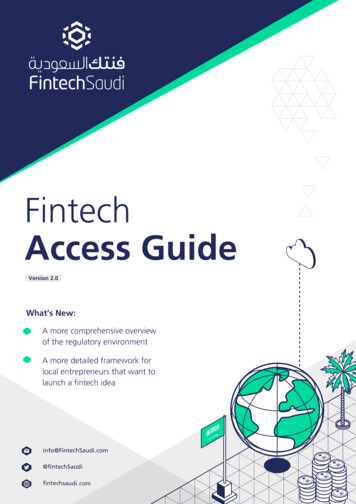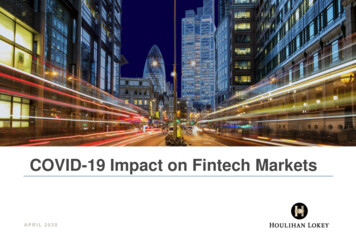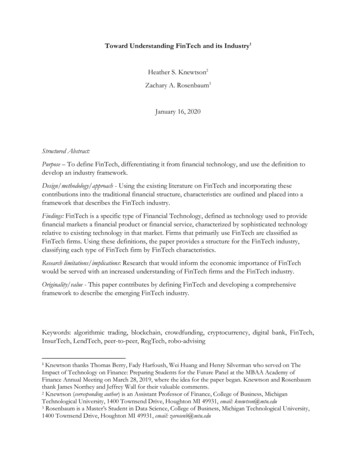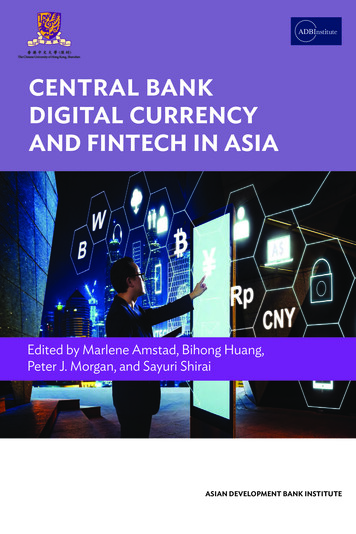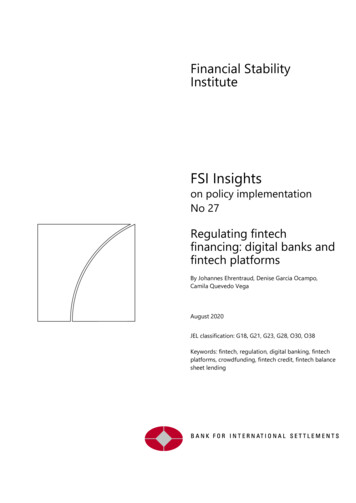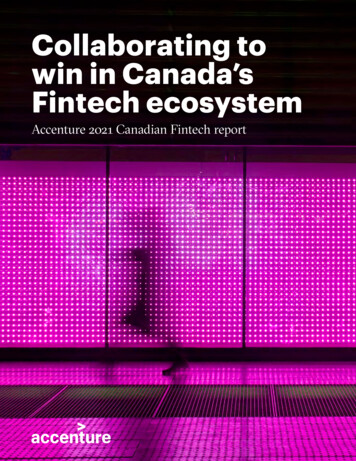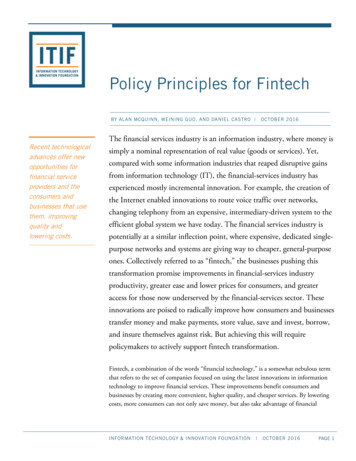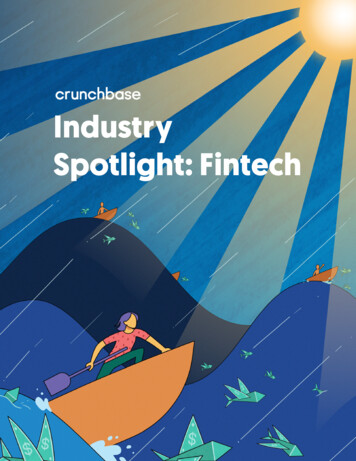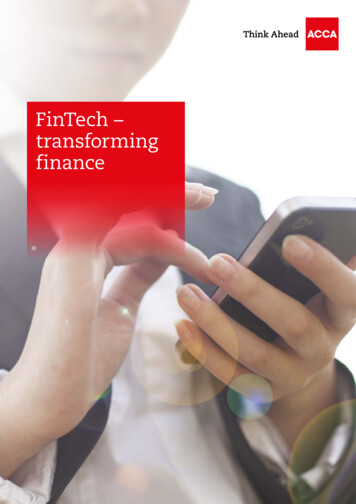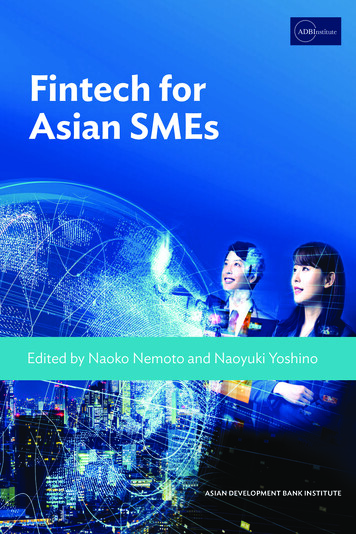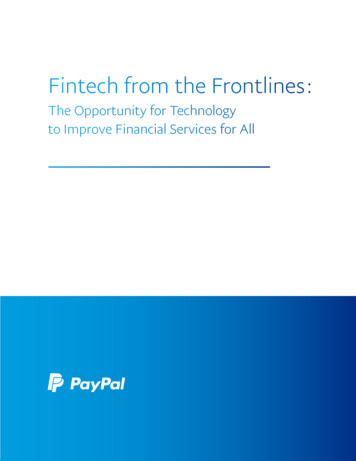
Transcription
Fintech from the Frontlines :The Opportunity for Technologyto Improve Financial Services for AllP. 1– Fintech from the frontlines
ContentsExecutive SummaryIntroductionI. Myths and Facts about fintechMyth: Fintech is NewMyth: Fintech is Outside the Traditional Banking SystemMyth: Fintech is UnregulatedFact: Fintech is MobileFact: Fintech is about PartnershipsFact: Fintech is Global47101113141618II. Fintech in Action: Case Studies from the FrontlinesPayments: Check to MobileCredit: Standard to Alternative DataWealth Management: Manual to Automated Advising192124III. Why Fintech Matters: Enhancing Securityand Enabling OpportunityEnhancing SecurityEnhancing Authentication with BiometricsProtecting Against Data Abuse with TokenizationUncovering Illicit Activity with Real-time MonitoringExpanding OpportunityAccessTransparencyChoiceCostsFinancial Health26272829303031313233IV. Creating an [e]cosystem for Fintech to Conclusion3436373842
Executive SummaryThe term ‘fintech’ has now become a part of the modern lexicon. Theterm is often used to describe tech startups that are presumably going to upend traditional financial institutions ( ie. banks ) through theuse of new technology. Such a characterization, however, misses a largeamount of what is truly transforming the financial services ecosystem.The singular term ‘fintech’ lumps togethera broad variety of financial services offeringswith different technologies, stakeholders,and risk profiles associated with each. Theterm also overlooks history as well as the trueopportunity for fintech, namely to betterserve customers (ie. simplifying experiences,lowering costs), and the enormous challenges associated with the financial services sector (ie. trust, security, and regulation).rather financial services has always beendriven by technology. Coinage is a technology, plastic cards are a technology, andAutomated Teller Machines (ATMs) are atechnology. The differentiator in the modern version of fintech is mobile technology,driven in particular by smartphones andthe Internet. Moreover, fintech is a trulyglobal phenomenon that has the potential to greatly improve people’s lives. It isalso essential to recognize that a significantAt PayPal, we believe that our nearly two portion of modern fintech is built in partdecades of experience givesnership with financial inus a strong position tostitutions and is subject toFintechisatrulyglobalspeak about what fintechregulatory scrutiny.phenomenon that hasreally is. This paper is ourattempt to provide an in- the potential to greatly Fintech has resulted in asider’s perspective on theimprove people’s lives. significant shift in severalpotential and the reality ofareas of financial services.fintech. We hope that itThere are certain fintechis useful to newcomers to the space, and innovations like virtual currencies thatthose that are seasoned veterans. We in- would be completely transformative of thetend this paper not to be definitive, but financial landscape, but those innovationsrather to be a thought-starter that will have yet to demonstrate traction at scale.stimulate a discussion on what we collec- The innovations that have been successfultively want for the future of fintech.at scale to this point tend to be improvements to the retail financial services expeThe interaction of technology and financial rience, leveraging technology to enhanceservices is not something entirely new, but the user experience. In payments, PayPalP. 4– Fintech from the frontlines
has seen first-hand the shift from cash tomobile payments, but there is still a greatdeal of room for continued innovation inthis space. Credit, both for small businessand consumers, has also been impactedby introducing new data elements to thetraditional metrics utilized in underwriting.Finally, people looking to build and managetheir wealth no longer need to have accessto elite advisors, but rather can leveragebig data and algorithms to manage andgrow their savings.The real impact of fintech, however, is notfancy new apps providing traditional financial experiences, but rather the meaningful improvements fintech can make inthe lives of those using financial services.Fintech can result in enhanced trust andsecurity with innovations like biometricauthentication, cryptographic transaction protection through tokenization, andbig data transaction monitoring. Fintechcan also facilitate the democratization offinance by lowering the costs of financialservices and expanding access and participation in every level of society.The current financial services ecosystemwas not designed for fintech, and the gapsthat need to be reformed are in a variety ofareas. Identity is a precursor to access tofintech, yet identity continues to languishin analog forms that are difficult to buildupon for the provision of digital services.Authentication is essential for safety andsecurity, but classical methods and policyproposals continue to dominate the discussion of authentication.Security hasbeen improved through fintech, but it hasRegulation must be createdin a manner that is basedupon performance ratherthan based upon the typeof technology.also shifted the risk profile to the securityof data, and best practices on data securityare not being adopted throughout the ecosystem. Finally, with the multitude of newactors entering the fintech ecosystem,there is a need for clarification on accountability and while regulatory sandboxes arean effective tool to defer questions aboutaccountability, more thinking needs to bedone on an ideal set of tools for regulatingfintech.We propose that financial services policymakers and regulators begin to thinklike fintech policymakers and regulators.That means embracing technology both interms of the opportunities it brings for users and for regulation.P. 5
We propose that fintech policymakers adopt a platform with 4‘e’s’ in mind : eIdentity – Digital forms of government-issued identification will be essential in a world where financial services canbe offered without any physical presence.These e-ID tools should be accessible, user-friendly, and affordable (preferably free)to ensure their wide adoption by users. eAuthentication – Authentication is acentral element of enabling fintech to scalein a secure manner. Regulations often havean analog view of the world, but digital andmobile technology enables a host of newdata elements to be used for improvingauthentication.This paper will proceed in four parts. PartI will contrast some of the myths and factssurrounding fintech. Part II will provideconcrete case studies that demonstrateprecisely how fintech is changing the landscape of financial services. Part III will describe why fintech matters by pointing tothe real impact that it is having on enhancing the security of and the economic opportunity provided by financial services.Finally, Part IV will point out gaps in theecosystem that currently inhibit fintechand limit its ability to truly transform people’s lives.P. 6– Fintech from the frontlines eSecurity – New forms of security arebeing enabled by technology, and government can provide a platform for information sharing about security best practicesand systemic threats. eRegulation – Technology will continueto adapt in the fintech space; regulationmust be created in a manner that is basedupon performance rather than based uponthe type of technology; moreover, regulators can now leverage technology to improve the way they collect information,analyze it, and engage in supervision.Once again, we intend for this paper to bea thought-starter on fintech. We are stillin the early days of the modern fintechrevolution, and we hope to work with allstakeholders to ensure that the fintechecosystem is designed in such a mannerthat it will enable the maximum amount ofpeople to benefit from the positive innovations that fintech can enable.
IntroductionThere is heterogeneity surrounding this sector in terms of its definition,its impact, its practices, and its regulatory standing. This piece is not anattempt to provide the conclusive insight on each of these areas, butrather to help to clarify elements that should help the reader to betterunderstand recent fintech developments.PayPal sits in a very unique position in theworld of fintech. We are neither a startupbusiness nor a traditional financial institution, which seems to be the dichotomytypically adopted when discussing fintech.We are a company with nearly 20 years infinancial services and technology, operating in over 200 markets, and providing asuite of technology-enabled financial services either directly or through partnership. We invest in small fintech startups,partner with large bank networks, andbuild technology solutions for banks andnon-banks alike. We serve individuals,businesses, non-profits, and governmententities. We bring this broad view of financial services, a historical knowledge oftechnology development, and a global perspective to this white paper. Much of whatfollows is written from the perspective ofa company headquartered in the UnitedStates of America, but we have attemptedto explore the issues of the fintech sectorwith due recognition to the global experience of fintech and the many influencesthat are shaping the future.In the wake of the 2008 global financialcrisis, there has been a great deal of glob-al upheaval in the financial services sector.Traditional financial institutions have shifted their strategies as a result of economicrealities, lack of trust, and a new regulatory landscape. Interestingly, at around thetime that the housing bubble in the UnitedStates began to foreshadow a larger financial crisis, Apple launched the iPhone inFebruary of 2007. The smartphone revolution that followed has transformed a rangeof sectors from retail to transportation,and financial services is no different. Thispaper focuses on that nexus of technologyand financial services in the modern era.Fintech is a term that could apply to anyapplication of technology to the financialsystem. But, for the purposes of this paper, we will be excluding discussions of Insurance and Investment Banking, focusinginstead on how technology is transformingRetail Banking. The disaggregation of thetraditional retail bank is often displayed byreferring to this graphic from CBinsights,which charts the multitude of technologyfirms that are providing services like credit, wealth management, and payments services.P. 7
One key factor to note from this graphic,however, is that the core functionality of“banking” is not being “disrupted” by technology firms (more to come on this later).There are also some important learningsthat the graphic does not show. First, thegraphic is heavily focused on the US landscape. Fintech is a global phenomenon andthe experiences in other developed countries in the developing world is quite different. Second, the graphic does not take intoaccount the fact that banks themselves(at times in partnership with fintechs) areP. 8– Fintech from the frontlinesproviding many of these services throughtechnological means. The baseline for thegraphic is a bank’s website, demonstrating that banks themselves are leveragingtechnology to offer their customers better services. Finally, the graphic does notevoke scale or impact in any way, and thereare areas where fintech has already mademeaningful differences in people’s financiallives, while in others it is still early days.Fintech exists because people’s expectations and preferences have evolved as a re-
Fintech exists because people’sexpectations and preferences haveevolved as a result of always-on,always-available mobile technology.sult of always-on, always-available mobiletechnology. Fintech is also the result ofpeople wanting, and in some cases needing, alternatives to the traditional system.Despite 700 million adults worldwide becoming bank account holders between2011 and 2014, 2 billion are still unbanked;most of whom live in Africa and Asia. Manyof those that are banked are still underserved; the US Federal Deposit InsuranceCommission reports that nearly 20% ofUS households are underbanked (meaning they have a bank account, but also useproducts outside the financial system).In the US, underserved consumers spent 141 billion in fees and interests to manage their financial lives in 2015 alone. Theproblems in the current system go beyondjust consumer finance. Over 50% of formal small and medium-size enterprises indeveloping economies are estimated to beeither unserved or underserved by the traditional financial sector. These are someof the gaps that fintech has the potentialto step into and provide tremendous socio-economic value.ers and regulators; engaging with industryis one of the best ways to foster learning.In areas where fintech is resulting in positive socio-economic outcomes an enablingenvironment needs to be created to extend and expand that impact. Clear andprecise rules and supervisory mechanismsshould be used to reign in activities thatresult in negative outcomes for people. Itis the outcome that should guide regulatory scrutiny of fintech rather than the technology or business model being used.Regulators and policymakers have beenworking overtime to catch up to the developments in the fintech space. There ismuch to be done. Understanding fintechshould be the primary goal for policymakP. 9
I. Myths and Facts about FintechAs with any new technological development, fintech has had its fairshare of hype. This hype has led to a wide variety of mischaracterizations. This section is an attempt to highlight some of the most egregious misconceptions surrounding fintech. Before understanding whatfintech is, it is helpful to point out what it isn’t. But, there are also someincredibly important facts about fintech that tend to get overlooked.This section seeks to highlight some of those facts and describe theirimportance.Myth : Fintech is NewThe first myth worth busting about fintechis that it is something new. PayPal has satat the nexus of tech and finance for nearly20 years, but technology has been changing financial services for decades beforePayPal was founded. Western Union builtupon its telegram business to offer moneytransfers over 100 years ago. The Automated Teller Machine (ATM), check imaging, and electronic bill payment are all examples of technology helping to improvefinancial services; these technologies are allover 30 years old. These products are notconsidered fintech, but they ought to be.The truth is that financial services have often evolved right alongside technologicaladvances. The development of the ATMis a perfect example. The precursor to theATM appeared in the late 60s and requireda customer to receive a one-time voucherfrom a teller before making deposits, paying bills, or obtaining cash. In 1969, the firstATM was launched by engineer DonaldWetzel and his company Docutel, leveraging magnetic stripe technology, also beingused in credit cards, to enable a cash withdrawal without the involvement of a teller.IBM, which helped to develop the magnetic stripe technology, partnered with LloydsBank in 1972 to create the self-service ATMwith an intuitive user interface, back endconnectivity, and PIN numbers stored in adatabase that was linked to the cards foradded security. IBM continues to work on“fintech innovations” with its recent announcement of a new Watson FinancialServices unit, designed to leverage its expertise in artificial intelligence to improvefinancial services risk management andcompliance.“Indeed, there are numerous instances in which nonbanks havebeen able to provide “bank-like” services at lower cost (or higher rate ofreturn) to the individual or corporatecustomer ”- US Federal Reserve Bank of MinneapolisP. 10
This quote is from 1982. Nonbanks havebeen offering financial services for manyyears before the modern Fintech revolution. There are unique innovations drivingthe current revolution, which we will discuss below. But, the notion that the roleof technology and non-bank competitionin the modern iteration of Fintech is some-thing entirely new is simply false. Ratherthan focusing on the newness of fintech orthe type of entity engaging in the activity,we ought to focus on the impact that innovations are having on improving the livesof people.Myth : Fintech is Outside the Traditional Banking SystemOften coupled with the notion that fintechis new is that fintech is occurring outsideof the traditional system. The majority offintech innovation, perhaps with the exception of certain developing countries, ishappening in connection with the existingfinancial system, and oftentimes in part-nership with traditional financial institutions. Moreover, this myth overlooks thefact that traditional financial institutionsthemselves are investing billions into fintech, both internally and through acquisition.There are cases where the existing financial system is seemingly bypassed entirely in favor of new models: Marketplace Lending – Instead of an in- dividual or company going to a traditionalbank for funding, they are instead matchedto private investors. The financial products created in these cases can also existoutside the system because the entitiesengaging in the transactions are not registered security dealers. Crowdfunding – Instead of privateaccredited investors providing funding,anyone can provide funding for a startupbusiness or idea.P. 11 – Fintech from the frontlinesMobile Money – Partnerships betweentelecom operators and retailers have enabled a new wave of financial services (ie.payments, credit, wealth management) tobe offered outside the traditional financialecosystem. Prepaid or closed loop debit cards –Often issued by non-bank entities like retailers and used by the unbanked. Bitcoin and other cryptocurrencies– these are an effort to revolutionizethe concept of money by removing the fiatfrom issuance and removing trusted intermediaries from transfer.
But, even with these models the formal financial system is often a major part of theprocess. Much of the capital for marketplace lending is provided by institutionalinvestors. Crowdfunding campaigns oftenresult in money being deposited into a formal bank. Even mobile money and Bitcoinoften leverage the traditional financial system for trust and liquidity.These innovative models garner a greatdeal of media fodder. But, their impacton the broader global financial system hasactually been quite small to this point. Inemerging markets, these newer models areseeing uptake because the existing financial system is not very robust. Moreover,in the UK products outside the traditionalbanking system are beginning to see traction, but in large part because a regulatoryand policy framework has been created toencourage them. UK regulators have enabled the creation of “challenger banks,”which can independently accept depositsand offer the full range of financial services.In the US, the fintech products that havescale tend to be in collaboration with existing financial institutions; core functionslike deposit taking continue to reside solelywith banks.Exhibit 6 : Collaborative fintech Investments vs. Competitive fintechInvetsments, 2010 / 15 ( M )Europe92North America2,8971,118APAC11,38714 %38 %40 %201060 %2015Note : Total excludes Other segmentSource : Accenture analysis on CB Insights dataP. 12 – Fintech from the frontlines20103,7817%16 %93 %84 %2010201560 %86 %62 %4340 %2015CollaborativeCompetitive
Newer fintech models may compete withtraditional financial institutions at first,but have also ended up aligning with traditional players. Case in point is OnDeck (amarketplace lender) signing a partnershipwith JP Morgan Chase. Other examplesinclude BBVA’s stake in Atom Bank in theUK, PayTm offering loans in partnershipwith 10 banks in India, and PayPal partnering with Equity Bank in Kenya.Many fintech companies are often focusedon collaborating with the existing financialsystem to create better user experiences.The infrastructure and access to scale thattraditional financial institutions provide isincredibly valuable, and very few fintechscan expect to scale unless they partnerwith the broader ecosystem . Importantly, fintech is not something that is alien tofinancial institutions. Banks spend an estimated 50-70 billion annually on internaltechnology investment; to give this number some context compare it to the 22billion invested in fintech companies globally in 2015.Myth : Fintech is UnregulatedNNew technologies tend to capture theattention of regulators, and, precisely because these technologies are novel, thereis often an assumption that there is a regulatory gap. But, as described above, mostof fintech is about improving the user experience and partnering with the existingfinancial system to hold deposits and enable investments, which is where much ofthe risk associated with financial serviceslies. Moreover, very few fintech firms provide an entire range of financial services,often choosing to focus on a single servicewhere there is need of improvement in theuser experience, limiting the systemic risksassociated with these services. Many ofthese vertical offerings are also regulatedat various levels.often regulated in a manner similar to“non-fintech” payment businesses. In theUS, this means regulation at the state levelunder Money Transmitter laws, which alsocover entities like Western Union and bikemessengers delivering a check. In the EU,fintech payments companies have beenbrought under the regulatory umbrellaof the Payment Services Directive. In India, the Federal Reserve Bank has createdthe notion of a Payments Bank to enablefintech payments providers to hold balances and provide services. In describingthe multitude of laws that currently applyto fintech payments companies it is clearthat the problem is not a lack of regulation,but rather a lack of coordination amongstdomestic regulators.Payments provides an interesting example. Fintech payments businesses areThere are certain cases where fintech enables money to be stored, transmitted, orP. 13
managed outside the traditional system asdescribed in the previous section, but regulations are beginning to be extended tomany of these products as well. For example, the Jumpstart Our Business Startups(JOBS) Act in the US provides regulatoryguidance on equity crowdfunding. CentralBanks across Africa and Asia have createdregulations to guide the entities providingmobile money services. The New YorkDepartment of Financial Services created a“BitLicense” for entities interested in providing exchange and payment services associated with Bitcoin.The vast majority of fintech applicationsare in fact regulated under existing financial regulations. Moreover, because fintechis often about enhancing the user experience, non-financial consumer protectionregulation often applies to fintech entities.For example, in the US, the Federal TradeCommission’s Section 5 Authority to combat unfair or deceptive practices applies toa broad swath of fintech companies. Privacy regulations in the European Union applyto fintech service providers. Thus, the notion that fintech firms are unregulated issimply false.Fact : Fintech is MobileMobile technology is causing upheaval ina number of sectors from transportationto agriculture to retail. Financial servicesis no different. In October of 2016, mobiledevices topped desktops in terms of globalInternet usage for the first time in history.In 2015, there were an estimated 2.6 billionsmartphone subscriptions globally – thatnumber is expected to be 6.1 billion subscriptions by 2020.This mobile revolution provides fintechservice providers with an unprecedentedinstant potential customer base. Additionally, it radically reduces the cost of offering a service because that product canbe offered without building out any costly physical infrastructure. Increasingly,mobile users The low barriers to entry infintech also means that there is increasedcompetition, which again lowers costs forend customers.Mobile is transforming every aspect of fintech. In payments, mobile represents thefirst change in device to initiate a paymentsince plastic cards were introduced to themarket in the 1950s. And, the value ofmobile is not that it is “faster” than plastic, but rather that it adds value to usersin the form of enhanced product offerings and increased security. Coupons canbe stored on a mobile device, fraud monitoring can be done actively through textmessages, and authentication can be verified by biometric and/or device signatures.Mobile data can provide fintech companiesin the credit space with important alternative data elements that they can use toP. 14
And, the value of mobileis not that it is “ faster ”than plastic, but rather thatit is more efficient and addsvalue to users.assess credit. Mobile apps are becomingincreasingly popular, particularly amongMillennials, as a way to manage transactionaccounts. These apps coupled with theSmartphone’s camera can also take pictures of physical checks in order to enabledirect deposit or cards to enable funding ofa digital wallet.We are still in the early days of the evolution of mobile’s impact on fintech. Theglobal mobile payments market is expected to grow at a compound annual growthrate of 36% by 2020. Biometrics are onlyjust being implemented into modernsmartphones, enabling far more secure andaccurate forms of authentication. Wealthmanagement apps continue to evolve inthe information they present and the control they provide users in analyzing andadjusting their savings. The mobile deviceprovides a canvas upon which software willcontinue to develop and provide tailoredfinancial services directly to customers inan always accessible, simple, and transparent format.P. 15 – Fintech from the frontlines
Fact : Fintech is about PartnershipsThe scale and nature of the challenges forthe future of the financial system require arange of skills and a portfolio of assets thatcan rarely be found within a single organization. Whether processes involve customer-facing interfaces or back-office automation, companies providing specializedtechnology are radically changing the wayfinancial institutions and systems operate.Some of these innovations are in less-regulated aspects of financial services and aretherefore able to rapidly scale. In a heavilyregulated segments of the industry, however, continued progress likely will involvecooperation and integration between regulated financial institutions and the providers of disruptive technologies.credit value propositions that are moremeaningful to consumers. Similarly, theemergence of large third party serviceproviders that run the back-office authorization, clearing and settlement systemsfor credit card issuers and merchants havemade those systems more efficient.The very term “financial technology” is indicative of the convergence of the worldsof “finance” and “technology.” The barriers between those worlds have fallen, or atleast become much more porous, as thetechnological revolution has forced regulated financial institutions to innovate at amuch more rapid rate than has been seenin the past, while technology providersthat seek to disrupt calcified financial systems have begun to fall more fully underthe financial regulatory umbrella.Partnerships between traditional financialservices companies and fintech firms arenow becoming commonplace. In a surveyof 70 executives at UK-headquartered financial services companies, 25% reportedthat they had engaged in a joint venturewith a fintech in the past 3 years, and nearly 50% stated that they planned to engagein a joint venture with a fintech in the nextthree years.For example, there is a long history ofbanks partnering with third parties in order to make various types of credit products more readily available to the massmarket. Even a simple innovation like thecredit card has reached ubiquitous levelsof distribution in part through partnerships between banks and retailers or affinity partners who collaborate to produceInnovations like electronic or mobile wallets continue to build on this infrastructure to improve the overall utility, ease ofuse, and security of these systems. Standalone innovations can be disruptive andforce traditional systems to evolve, but it isthrough partnership that technology providers and established financial servicesproviders are best able scale solutions.The benefits of these types of partnershipsfor customers is clear. Let’s look at the example of financial management fintechtools that use screen-scraping versus thosethat partner for direct data feeds. Digital financial management tools (ie. Mint.com, Yodlee) initially used screen-scraping technologies to take consumer banking credentials to gather information onbehalf of consumers by logging-in to theconsumer’s bank accounts in an automatP. 16
ed way. While meeting an important consumer need to collect an overall financialpicture based on data derived from multiple sources, the screen-scraping approachhad drawbacks. Some implementationsplaced burdens on bank systems due toautomated log-ons designed to ensurethat up-to-date information was presented to consumers. Further, the collectionof banking credentials created another potential point of failure and risk of unauthorized access to bank accounts. Throughcooperative relationships with banks thathold consumer accounts, however, dataaggregation sites are able to establishmore secure data feeds without using consumer log-on credentials, improve datasecurity and quality, enhance the customer experience and reduce risk.Lastly, it is worthwhile to look at the partnership between the Royal Bank of Scotland (RBS) and Funding Circle. RBS andFunding Circle have different methodsand practices for underwriting loans. Thispartnership involves the RBS referring declined small business loan applications onto Funding Circle, increasing the likelihoodthat an entity will
the Internet. Moreover, fintech is a truly global phenomenon that has the poten-tial to greatly improve people’s lives. It is also essential to recognize that a significant portion of modern fintech is bu
